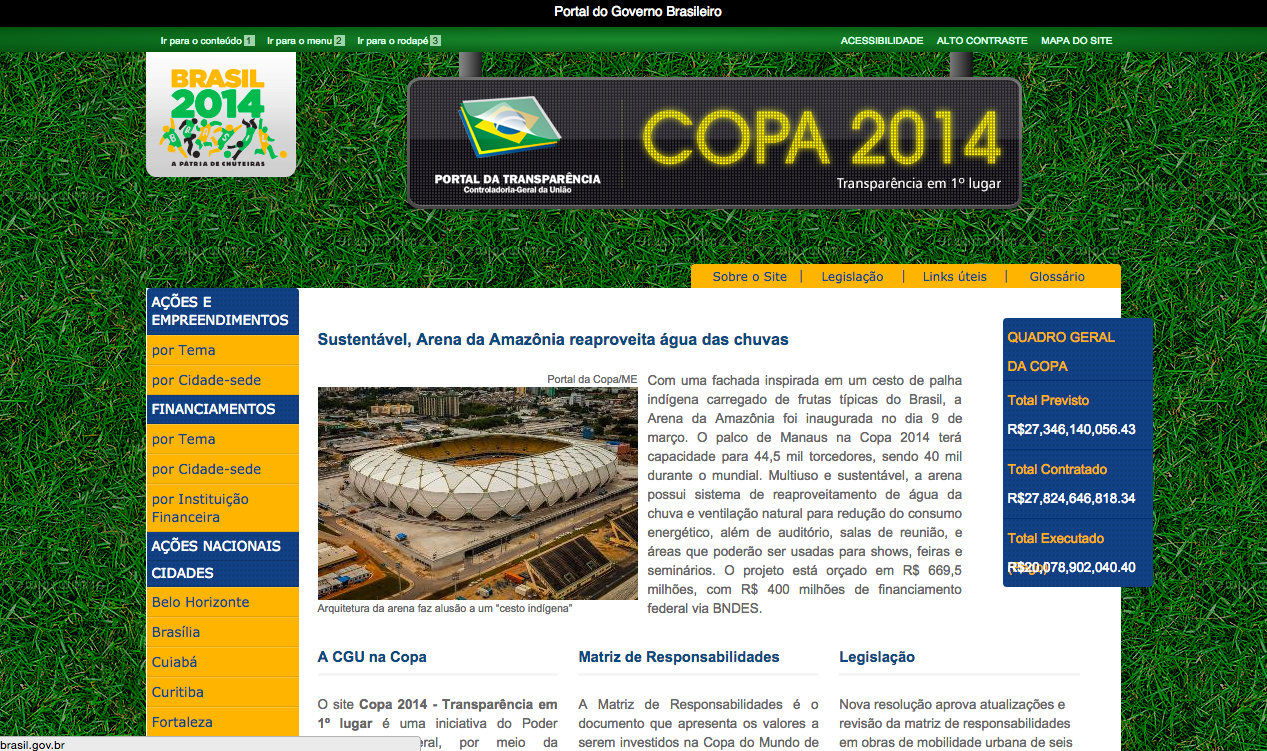The Global Impact of Open Data
Brazil’s Open Budget Transparency Portal
Making Public How Public Money Is Spent
by Auralice Graft, Stefaan Verhulst and Andrew Young*
Reference
1Corruption Perceptions Index 2014: Results. Transparency International. http://www.transparency.org/cpi2014/results
2Rio de Janeiro metropolitan area profile. Bookings Global Cities Initiative. Accessed October 13, 2015. http://www.brookings.edu/about/programs/metro/~/media/455849BC16B24B7CA98FE5C5FDE3C0EF.ashx
3Barth, Philipp. “The persistence of corruption in Brazilian politics.” DW. May 10, 2014. http://www.dw.com/en/the-persistence-of-corruption-in-brazilian-politics/a-17974970.
4Cruz, Marcos and Alexandra Lazarow. “Innovation in government: Brazil.” McKinsey & Company Insights & Publications. September 2012. http://www.mckinsey.com/insights/public_sector/innovation_in_government_brazil.
5 “Business Corruption in Brazil.” Business Anti-Corruption Portal. Accessed October 13, 2015. http://www.business-anti-corruption.com/country-profiles/the-americas/brazil/show-all.aspx.
6Savarese, Mauricio. “No End in Sight for Brazil’s Petrobras Scandal.” Americas Society / Council of the Americans. August 5, 2015. http://www.as-coa.org/articles/no-end-sight-brazil%E2%80%99s-petrobras-scandal.
8Brazil: New Access to Information Law becomes effective today.” Article 19. May 16, 2012. https://www.article19.org/resources.php/resource/3208/en/brazil:-new-access-to-information-law-becomes-effective-today.
9New Brazilian Data Portal Dados.Gov.Br – Powered by CKAN.” Open Knowledge Blog. May 10, 2012. http://blog.okfn.org/2012/05/10/new-brazilian-portal-dados-gov-br-made-by-citizens/
10http://15iacc.org/agenda/agenda-day-4/the-consocial-in-brazil-empowerment-and-governmental-agenda/
11Barbassa, Juliana. “Brazil Freedom of Information Law Passed.” The World Post. May 17, 2012. http://www.huffingtonpost.com/2012/05/17/brazil-freedom-of-information_n_1525131.html.
12“OECD Integrity Review of Brazil: Managing Risks for a Cleaner Public Service.” OECD Publishing. 2012. http://www.keepeek.com/Digital-Asset-Management/oecd/governance/brazil-oecd-integrity-review_9789264119321-en.
13GovLab interview with Leodelma de Marilac Felix, Finance and Control Analyst, Transparency and Public Oversight Directorate, Corruption Prevention and Transparency Secretariat, Office of the Comptroller General, Brazil, August 18, 2015.
14“OECD Integrity Review of Brazil: Managing Risks for a Cleaner Public Service.” OECD Publishing. 2012. http://www.keepeek.com/Digital-Asset-Management/oecd/governance/brazil-oecd-integrity-review_9789264119321-en.
15“OECD Integrity Review of Brazil: Managing Risks for a Cleaner Public Service.” OECD Publishing. 2012. http://www.keepeek.com/Digital-Asset-Management/oecd/governance/brazil-oecd-integrity-review_9789264119321-en
16 http://www.portaltransparencia.gov.br/noticias/DetalheNoticia.asp?noticia=1 Translated from Portuguese by Google.
17http://www.cgu.gov.br/assuntos/transparencia-publica/portal-da-transparencia Translated from Portuguese by Google.
18GovLab interview with Otávio Moreira de Castro Neves, Coordinator for Open Government and Transparency, Transparency and Public Oversight Directorate, Corruption Prevention and Transparency Secretariat, Office of the Comptroller General, Brazil. August 6, 2015.
19Hage Sobrinh, Jorge. “Brazil’s Transparency Portal Freely Delivers Information to Citizens.” Transparency & Accountability Initiative. September 19, 2011. http://www.transparency-initiative.org/news/brazils-transparency-portal-freely-delivers-information-to-citizens.
20“OECD Integrity Review of Brazil: Managing Risks for a Cleaner Public Service.” OECD Publishing. 2012. http://www.keepeek.com/Digital-Asset-Management/oecd/governance/brazil-oecd-integrity-review_9789264119321-en.
21“OECD Integrity Review of Brazil: Managing Risks for a Cleaner Public Service.” OECD Publishing. 2012. http://www.keepeek.com/Digital-Asset-Management/oecd/governance/brazil-oecd-integrity-review_9789264119321-en.
22Cruz, Marcos and Alexandra Lazarow. “Innovation in government: Brazil.” McKinsey & Company Insights & Publications. September 2012. http://www.mckinsey.com/insights/public_sector/innovation_in_government_brazil.
24GovLab interview with Otávio Moreira de Castro Neves, Coordinator for Open Government and Transparency, Transparency and Public Oversight Directorate, Corruption Prevention and Transparency Secretariat, Office of the Comptroller General, Brazil. August 6, 2015.
25OECD Integrity Review of Brazil: Managing Risks for a Cleaner Public Service.” OECD Publishing. 2012. http://www.keepeek.com/Digital-Asset-Management/oecd/governance/brazil-oecd-integrity-review_9789264119321-en
26“Credit happy Brazilian minister admits mistake and resigns.” Merco Press. February 3, 2008. http://en.mercopress.com/2008/02/03/credit-happy-brazilian-minister-admits-mistake-and-resigns.
27 GovLab interview with Otávio Moreira de Castro Neves, Coordinator for Open Government and Transparency, Transparency and Public Oversight Directorate, Corruption Prevention and Transparency Secretariat, Office of the Comptroller General, Brazil. August 6, 2015.
28“In 2008, corporate cards yielded CPI’s.” Acervo. January 5, 2013. http://acervo.estadao.com.br/noticias/acervo,em-2008-cartoes-corporativos-renderam-cpis,8813,0.htm.
29Cruz, Marcos and Alexandra Lazarow. “Innovation in government: Brazil.” McKinsey & Company Insights & Publications. September 2012. http://www.mckinsey.com/insights/public_sector/innovation_in_government_brazil.
30Cruz, Marcos and Alexandra Lazarow. “Innovation in government: Brazil.” McKinsey & Company Insights & Publications. September 2012. http://www.mckinsey.com/insights/public_sector/innovation_in_government_brazil.
31GovLab interview with Otávio Moreira de Castro Neves, Coordinator for Open Government and Transparency, Transparency and Public Oversight Directorate, Corruption Prevention and Transparency Secretariat, Office of the Comptroller General, Brazil. August 6, 2015.
32GovLab interview with Otávio Moreira de Castro Neves, Coordinator for Open Government and Transparency, Transparency and Public Oversight Directorate, Corruption Prevention and Transparency Secretariat, Office of the Comptroller General, Brazil. August 6, 2015.
33GovLab interview with Otávio Moreira de Castro Neves, Coordinator for Open Government and Transparency, Transparency and Public Oversight Directorate, Corruption Prevention and Transparency Secretariat, Office of the Comptroller General, Brazil. August 6, 2015.
34“The cost of corruption in Brazil.” Transparency International. March 13, 2015. http://www.transparency.org/news/feature/the_cost_of_corruption_in_brazil
35“Combating corruption in Brazil depends on agility in ritual procedure, says Brazilian General Comptroller Jorge Hage in interview with UNODC.” United Nations Office on Drugs and Crime. February 9, 2011. https://www.unodc.org/lpo-brazil/en/imprensa/entrevistas/2011/02/09-combate-a-corrupcao-no-brasil-depende-de-maior-agilidade-no-rito-processual-afirma-jorge-hage-em-entrevista-ao-unodc.html
36GovLab interview with Otávio Moreira de Castro Neves, Coordinator for Open Government and Transparency, Transparency and Public Oversight Directorate, Corruption Prevention and Transparency Secretariat, Office of the Comptroller General, Brazil. August 6, 2015.
37GovLab interview with Leodelma de Marilac Felix, Finance and Control Analyst, Transparency and Public Oversight Directorate, Corruption Prevention and Transparency Secretariat, Office of the Comptroller General, Brazil, August 18, 2015.
38GovLab Interview with Izabela Corrêa, former Coordinator for Promotion of Ethics, Transparency and Integrity, at the Directorate for Corruption Prevention, 2007 to 2012. Interview on August 21, 2015.
39“Brazilian Supreme Court Upholds the Mandatory Disclosure of Salary Information for Public Officials.” Transparency Audit Network. May 2015. http://www.transparencyaudit.net/news/2015-05/brazilian-supreme-court-upholds-mandatory-disclosure-salary-information-public
41Beghin, Nathalie, Carmela Zigona, Gisele Craveiro, Marcelo Tavares. “Open Data in Brazil: budget transparency and people’s rights.” Open Data Research Network. 2014. http://www.opendataresearch.org/sites/default/files/publications/INESC%20-%20ODDC%20Poster_Inesc_Brazil%20(1).pdf.
42 GovLab interview with Otávio Moreira de Castro Neves, Coordinator for Open Government and Transparency, Transparency and Public Oversight Directorate, Corruption Prevention and Transparency Secretariat, Office of the Comptroller General, Brazil. August 6, 2015.




